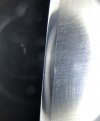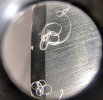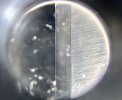- Joined
- Jan 8, 2019
- Messages
- 26
Lately I’ve gotten interested in knives and knife sharpening, and am planning to start a knife collection.
As I was saying in my introduction thread, I’m very interested in metallurgy and the comparison of different knife steels, and how the steel can be tailored through alloying in order to achieve the desired performance requirements, whether the priority is edge retention, toughness, or resistance to corrosion.
I’ve really gotten interested in freehand sharpening, and I’ve sorta gotten addicted to Michael Christy’s YouTube channel. He is extremely skilled at sharpening, and he inspires me to want to learn to bring a knife to the level of “hair-whittling sharp”.
I have a basic understanding of the concept of sharpening. I enjoy detailing my cars, and, interestingly, there is some crossover between polishing the finish of a car and sharpening, in that you are removing material to get the desired result, starting with a coarse compound (or stone) and progressing to medium, then fine, etc.
So, I don’t have many knives now. I just bought my first “nice” pocket knife - a Ferrum Forge “Gent” sold by Massdrop (S35VN). I also have a cheap $25 Camillus in AUS-8 and a Kershaw Leek in 14C28N.
Here’s a short closeup detail video I uploaded on my Gent:
After watching Michael Christy’s channel, I’ve got my eye on a Spyderco Military... Not sure yet what steel I’d want it in. I like the idea of a supersteel, but I’d want to be able to maintain the edge.
Here’s one of Michael’s videos. It features the Spyderco Military with carbon fiber handle scale and Ti framelock, in S90V alloy:
In the kitchen, I have a cheap set of Chicago Cutlery kitchen knives and a small set of Cutco (which are good quality), however, among those Cutco knives, the only one that isn’t serrated is my Chef knife.
I intend to learn on the cheaper knives before attempting to sharpen something like my Gent (S35VN).
So, my question is, with so many different stones and strops and compounds available, is there some consensus on a good brand that offers good value? When I’m buying something, I like a lot of value for my money. On a scale of 1-10, if 10 is the absolute best, I tend to usually go for the 6-7, if that makes sense. I don’t have to have the very best, but I want some quality and longevity from an item.
What about sets? Would there be a kit available that would include a few stones? Say, a coarse, medium, fine, and super-fine?
I’d like to be able to sharpen my kitchen knives and steak knives as well... Can the stones that would ordinarily be used to sharpen pocket knives, also be used to put a good edge on my kitchen knives?
As I say, I’d love to get to the level of skill that it takes to bring up a “hair-whittling” edge on a knife. However I do realize that it takes time and practice, and I don’t expect to get there overnight.
So what stones and strop(s) should I get?
Thanks guys,
John
As I was saying in my introduction thread, I’m very interested in metallurgy and the comparison of different knife steels, and how the steel can be tailored through alloying in order to achieve the desired performance requirements, whether the priority is edge retention, toughness, or resistance to corrosion.
I’ve really gotten interested in freehand sharpening, and I’ve sorta gotten addicted to Michael Christy’s YouTube channel. He is extremely skilled at sharpening, and he inspires me to want to learn to bring a knife to the level of “hair-whittling sharp”.
I have a basic understanding of the concept of sharpening. I enjoy detailing my cars, and, interestingly, there is some crossover between polishing the finish of a car and sharpening, in that you are removing material to get the desired result, starting with a coarse compound (or stone) and progressing to medium, then fine, etc.
So, I don’t have many knives now. I just bought my first “nice” pocket knife - a Ferrum Forge “Gent” sold by Massdrop (S35VN). I also have a cheap $25 Camillus in AUS-8 and a Kershaw Leek in 14C28N.
Here’s a short closeup detail video I uploaded on my Gent:
After watching Michael Christy’s channel, I’ve got my eye on a Spyderco Military... Not sure yet what steel I’d want it in. I like the idea of a supersteel, but I’d want to be able to maintain the edge.
Here’s one of Michael’s videos. It features the Spyderco Military with carbon fiber handle scale and Ti framelock, in S90V alloy:
In the kitchen, I have a cheap set of Chicago Cutlery kitchen knives and a small set of Cutco (which are good quality), however, among those Cutco knives, the only one that isn’t serrated is my Chef knife.
I intend to learn on the cheaper knives before attempting to sharpen something like my Gent (S35VN).
So, my question is, with so many different stones and strops and compounds available, is there some consensus on a good brand that offers good value? When I’m buying something, I like a lot of value for my money. On a scale of 1-10, if 10 is the absolute best, I tend to usually go for the 6-7, if that makes sense. I don’t have to have the very best, but I want some quality and longevity from an item.
What about sets? Would there be a kit available that would include a few stones? Say, a coarse, medium, fine, and super-fine?
I’d like to be able to sharpen my kitchen knives and steak knives as well... Can the stones that would ordinarily be used to sharpen pocket knives, also be used to put a good edge on my kitchen knives?
As I say, I’d love to get to the level of skill that it takes to bring up a “hair-whittling” edge on a knife. However I do realize that it takes time and practice, and I don’t expect to get there overnight.
So what stones and strop(s) should I get?
Thanks guys,
John



